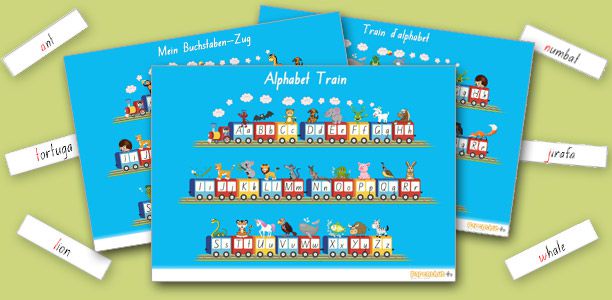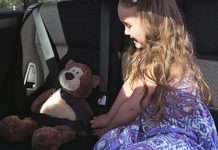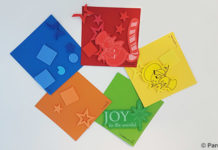Age
2-8 years
Duration of activity
There are many different games and activities you can play with the alphabet animal train poster. You can fill in a few spare minutes or spend an hour or more.
Materials/equipment
- Alphabet poster- animal train- there are many different animal train options you can print, depending on the language/s that your child is learning, and the spaces you have for hanging the animal train.
- A ruler or other instrument for pointing at the poster (optional- you can just use your finger).
- It may also be useful to have a set of alphabet flashcards handy so you can help your child by showing them the letters on the flashcards if they get stuck.
Cost
It will cost about $3 to print the alphabet animal train poster in colour. If you decide to laminate the poster to make it more durable, you’ll spend about $0.50 on laminating pouches to use in your home laminating machine.
Preparation
- Print the alphabet animal train poster and laminate (optional).
- Hang the poster at your child’s eye level.
What to do
Singing alphabet songs
The alphabet animal train poster is a great resource to help your child learn more about the letters of the alphabet while they sing alphabet songs. For example you could sing the alphabet animal chant or the ABC song while pointing at the poster.

- This activity is suitable for children aged 2-4 years who are learning to sing alphabet songs and recognise letters of the alphabet.
- Stand with your child near the alphabet animal train poster, which should be hung at their eye level.
- Ask your child to choose an alphabet song they would like to sing, or if your child is just beginning to learn alphabet songs, choose a song to teach them.
- Ask your child to sing the song, or sing to them if they do not yet know the lyrics.
- Tell your child that the animal alphabet train poster contains all the letters of the alphabet they have just sung about.
- Tell them that they/you will sing the song again but this time they/you will point to the letters of the alphabet.
- Sing the song again, but this time slowly so that you and/or your child can point to each letter as you sing it in the song.
- When you have finished singing, talk to your child about the alphabet and ask them to point to and name some of the letters and/or animals that they already know. Talk about the name of the letter (hard ‘aay’) and that it makes the sound (soft a) ‘a’ for ant.
Matching animal word labels
- This activity is suitable for 5-7 year olds.
- You will also need a set of printed alphabet animal train word labels and a chunk of blu-tack to play. You may like to use the entire set of word labels or focus on just a few letters that your child is learning now, depending on their stage of development.
- Show your child the word labels and explain to them that for each carriage of the alphabet animal train there is a label with the name of the animal on it. Tell them that to do this activity they need to find the label that matches each carriage of the train and stick it underneath the carriage.
- Point out that the first letter of each animal label is printed in red and that is the letter they need to match to on the animal train.
- Ask your child to choose an animal name label to match.
- Ask them to point to and name the first letter of the animal name.
- Ask them to find the same letter on the animal train.
- If they get stuck, help them out by singing the alphabet song to identify the letter names and/or discussing the features of the letters (e.g. the circles, straight and curved lines they contain).
- When they have correctly identified the carriage of the animal train, ask them to pinch of a small piece of blu-tack for the word label and stick it underneath the carriage.
- Repeat for all letters in the set.
- When you have finished playing (or after a short period of time if you want to leave the animal name labels hanging for a while), ask your child to remove all the word labels and peel the blu-tack off the back and roll it into a ball.
- Ask your child to pack the labels away so they are ready to play with next time.
Matching small objects to animal train carriages
- This game is suitable for children aged 4-7 years

- You will need to collect from around the house and yard a range of small, light-weight objects which can be attached to the poster using blu-tack. For example you could use a toy ant, a button, a card or toy car, etc.
- Show your child the objects and explain that every object’s name starts with a letter of the alphabet.
- Tell them that to do this activity they need to work out which letter of the alphabet the object’s name starts with and match it to the carriage of the alphabet animal train which starts with the same letter.
- Ask them to choose the object they would like to match first and tell you the name.
- Ask them what letter the object starts with. If they get stuck help them out by saying the name of the animal that starts with the same letter, and if they still can’t work it out, saying the section of the alphabet animal chant for that letter (e.g. saying, “you have a button and that starts with the same letter as bat,” and if they can’t work it out saying, “b is for bat, b, b, b, b, bat. Bat and button both start with letter b.”)
- Next ask them to find the carriage on the train for the letter. If they get stuck show them an alphabet flashcard for that letter and ask them to find the same letter on the train.
- When they have found the carriage, ask them to pinch off some blu-tack and use it to stick the object to the poster creating an exciting 3-dimensional train poster.
Find the animal train carriage starting with …
- This activity is suitable for 4-6 year olds who can already name and recognise some or all of the letters of the alphabet.
- Stand or sit with your child near the alphabet animal train poster and tell them that to do this activity they need to find the right carriage of the alphabet train when you say a letter.
- Say a letter of the alphabet. If your child is still learning and only knows some letters of the alphabet, start with letters they know and add in some that they are starting to learn.
- Ask your child to point to the corresponding carriage of the animal alphabet train and say the name of the animal in that carriage, name the letter and say the letter sound.
- If your child has trouble finding the letter, say the section of the animal chant for that letter and ask them to find the carriage with that animal in it (e.g. say “e is for elephant, e, e, e, e, elephant. Can you see an elephant in the train?”) When they have found the animal, get them to point to the letter and name it.
- For older children have a set of animal word labels handy. As they find each letter in the train, get them to also find the corresponding animal word label and stick it to the carriage.
Tips
- Choose a place where your child will be able to concentrate on the poster while they sing and play. A place with few other distractions is a good one. If you hang it on the glass door leading to your garden, chances are your child will be distracted by the world of adventure the backyard offers. You might find that they have little interest in the alphabet if other options like playing in the dirt with the dog or using outdoor play equipment like swings and the trampoline are waiting on the other side of the glass.
- If your child is learning the alphabet in two or more different languages, some letters of the alphabet will make different sounds in each language. So that your child doesn’t get confused, it’s a good idea to practice the alphabets separately, in planned sessions. For example instead of singing the English alphabet, followed by the French alphabet, it’s better to do all your English alphabet practice at a certain time of day (e.g. in the morning) and all your French alphabet practice at another time of day (e.g. in the afternoon).
- You may also like to hang the different language animal train posters in different areas of the house so that your child knows, for example that when they are in the toilet and washing their hands afterwards they are always singing the Spanish alphabet, whereas when they are in their bedroom they are always singing the German alphabet.
- For older children ask them to use animal names or object names in sentences. They may make up a proper sentence (e.g. The elephant was bigger than the cat.) or silly sentences (e.g. Molly mouse moves marbles, mice and mandarins).
Extension activities
- For older children ask them to use animal names or object names in sentences. They may make up a proper sentence (e.g. The elephant was bigger than the cat.) or silly sentences (e.g. Molly mouse moves marbles, mice and mandarins).
Educational outcomes
Literacy skills
Letter recognition and phonological awareness (letter-sound association)
The alphabet animal train poster uses the standard Australian NSW foundation style handwriting font, so the letters on the poster look like the letters many children learn to write in Australian primary schools. Using the poster while you sing songs or look at words and objects means your child will not only learn how to say the names of the letters of the alphabet (e.g. aay, bee, cee), but also learn to associate the names with the written letters with their sounds (a,a, ant, b,b, bat, c,c, cat) and become familiar with their shape. This is referred to as phonological awareness or letter-sound association and is a vital foundation for reading and writing. Being able to associate the name and sound of a letter with an animal in the train or an object stuck to it often helps children remember and master their alphabet.
Unless children recognise each letter of the alphabet and associate individual letters and combinations of letters with particular sounds, they will not be able to read and write fluently. Children (and adults) read by looking at and interpreting each of the letters in each of the words they see. However a fluent reader does this automatically without thinking or even realising that they’re doing it.
Fluent reading depends on sub-conscious, automatic recognition and interpretation of the letters, meaning that the reader doesn’t even think about the letters. Instead they focus their attention and brain power on the meaning of the words and sentences they read. Children who do not master individual letter recognition and letter sound association, also have difficulty learning the sounds associated with pairs (e.g. sh) or groups (e.g. sch) of letters. This has a negative impact on their reading ability.
Toddlers and preschoolers
Doing alphabet activities like these with the alphabet animal train poster, which help your child master the names of the letters of the alphabet, letter recognition (the shapes of written letters) and letter-sound association (be able to say the correct sound when they hear a letter name or see a written letter), is the first step in teaching them to be fluent readers. Two years olds will have fun listening to words that sound the same and playing word games, for example saying the names of all objects starting with letter m, or hearing rhyming animal names like cat and bat. By three-four years children will be able to think of their own rhyming words and words which start with the same sound, even if they don’t necessarily know which letter words start with, or the letters that make the rhyming sounds. The alphabet animal train poster activities are a great way for pre-schoolers to learn new letters and sounds and master the ones they already know.
Early primary
By the time they start primary school most kids understand that certain sounds go with certain letters and are able to recognise and name some letters of the alphabet and associate them correctly with sounds. They usually have fun with the sounds letters make, playing with sounds to make new words or making up silly sentences with words they know. As they progress in the next couple of years they master their understanding of how different individual letters match to different sounds and also learn the variety of different sounds a single letter can make when combined with others letters.
Spelling, writing and reading
Recognising the shape of individual letters and associating them with sounds, as children learn to do when they play the alphabet animal train poster activities, is a foundation all children need before they can spell. A child’s spelling ability also influences their ability to read and write fluently and effectively. There’s no right age for a child to know how to spell; all kids develop different abilities at different ages. However they all follow the same pattern when it comes to learning to spell. Learning to analyse individual letters is the first step and associating the letters with their most common sounds (e.g. short sounds like those made by the letters in cat) follows. Without learning the individual letters and their simple sounds kids struggle to learn more complex sounds or to combine letters together to spell words.
Using words in sentences (see extension activities) helps children learn about writing and understand how the context in which a word is used in a sentence may influence its spelling. For example in the sentence ‘The tiger took two toothbrushes to the tap’ the word ‘two’ is used to represent the number and to indicate direction.
Language skills
Your child will have plenty of opportunities to improve their language skills as they do the alphabet animal train poster activities. They’ll be learning new words, for example the names of animals they are not yet familiar with, in one or multiple languages, depending on which alphabet trains you use. They’ll also practice using the English (or whatever language you speak to them in while doing these activities) for everyday conversation. This is a great opportunity for them to practice using words they already know in sentences, or experiment using words they’ve heard but never spoken before. For preschool age children who are learning to use simple grammar and combine words in sentences, every opportunity to practice pronouncing and combining words properly is important.
Children in primary school already have a complex understanding of the English language and are able to use a range of styles (grammar, word choice, tone of voice) to give their words meanings, for example to indicate they are speaking about the past or present or to emphasise particular parts of their speech. For example they’ll probably understand that the language they use while doing activities with you is a bit different to the language they might use in a school classroom or a formal situation.
Children will also learn new words and develop an understanding of the relationships between words as they see the spelling and hear the sounds, for example while attaching animal labels to the correct carriages of the train.
Communication and social skills
Your child will learn to communicate without even being conscious that they’re learning. Having a conversation or listening to and following instructions as you play these activities is a great way for your child to:
- Learn to listen carefully and follow instructions in the correct sequence. Four year olds will already be able to follow instructions with 3-4 steps.
- Answer and ask questions at correct times in the conversation, for example when they are asked a question or when they need a hand.
- Use body language to give their words extra meaning. Most obviously they’ll be doing a lot of pointing at letters in these activities, but they might also nod or shake their head, use their hands to help emphasise a point or make facial expressions to show happiness or frustration.
- Change their tone of voice to show, for example that they are excited, thoughtful or unsure.
Fine motor skills
Fine motor skills, or the skills to control the small movements of their fingers and hands develop rapidly in childhood and allow us to do everyday tasks like write, fasten buttons and pick up small objects. While doing the alphabet animal train activities, your child will use their fingers to do many different things. Each time they pick up, point at or manipulate an object with their fingers they’ll be showing off the fine motor skills they’ve already developed and further strengthening their finger muscles and control. For example:
- Holding a pointer with their hand and fingers (perhaps using pincer grasp – *picture*) strengthens the same muscles your child uses to hold a pencil when they are drawing or writing.
- Manipulating blu-tack, for example pinching off small amounts then rolling it into a ball to stick to the back of small objects or animal name labels will help your child learn to control the hand movements they need to make to manipulate objects.
- Picking up small objects and thin animal labels will help your child perfect their pincer grasp, that is their ability to pick up objects using only the tips of their thumb and index finger.
Mathematical skills
Although they’ll be thinking about the alphabet, reading and writing, children will also be learning to understand important mathematical concepts as they do alphabet animal train activities. For example when they choose objects or word labels to stick on the corresponding carriages of the train they will be learning and practicing key mathematical concepts like sorting, matching and categorising.
Downloads
- English
- French
- German
- Italian
- Spanish
References
- Virginia Early Childhood Development Alignment Program. Milestones of child development- A guide to young children’s learning and development from birth to kindergarten. 2009. (cited 26 July 2013). Available from: (URL Link)
- Columbia Developmental Progression of the Grasp. UNDATED. (cited 4 September 2014). Available from: (URL Link)
- Eastern Kentucky University- Occupational Therapy. Writing Grasps. 2011. (cited 4 September 2014). Available from: (URL Link)
- Calder T. Help your preschool child develop fine motor skills. 2006. (cited 12 May 2014). Available from: (URL Link)
- Andrews M. General Categories of Fine Motor Development. Michigan State University Extension. UNDATED. (cited 28 March 2014). Available from: (URL Link)
- NSW Government. Teaching Spelling K-6. 2003. (cited 24 June 2014) Available from: (URL Link)
- Felton. Teacher letter-sound association. Arizona Department of Education. 2011. (Cited 23 June 2014). Available from: (URL Link)
- Government of South Australia- Department of Education and Children’s Services. Spelling: from beginning to proficiency. 2011. (cited 24 June 2014) Available from: (URL Link)
- Australian Curriculum and Reporting Authority. Australian Curriculum- English. Undated. (cited 16 June 2014) Available from: (URL Link)
- NSW Department of Education and Communities. NSW Foundation Style Handwriting. 2011. (cited 19 September 2014) Available from: (URL Link)



 (7 votes, average: 4.43 out of 5)
(7 votes, average: 4.43 out of 5) 






